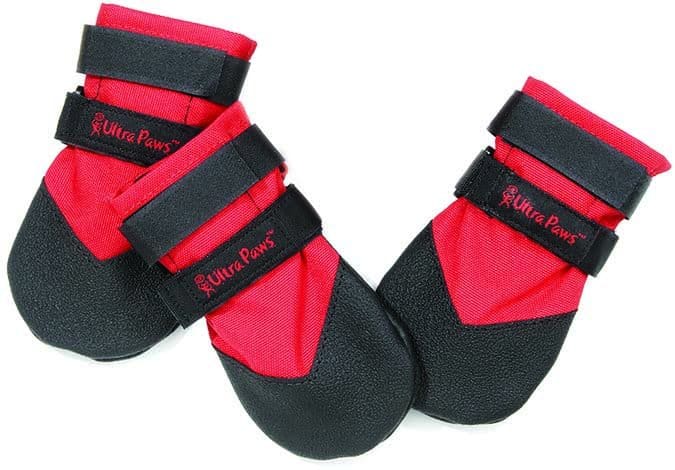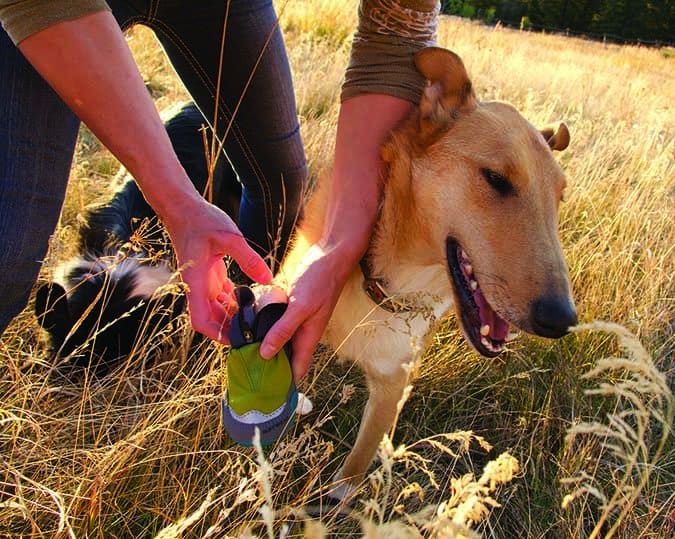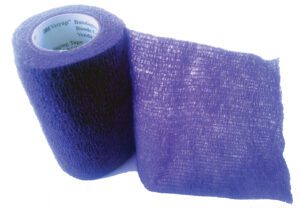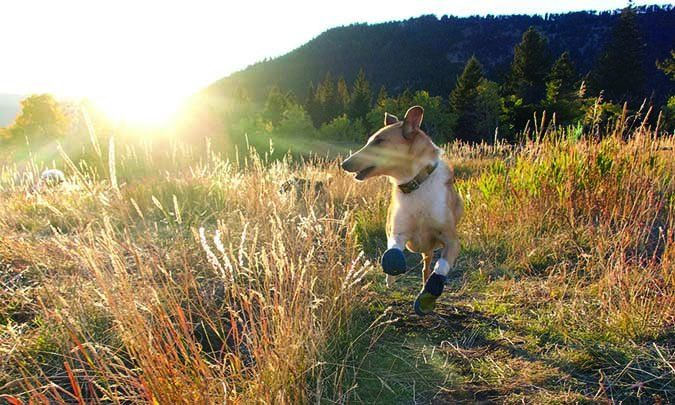On a beautiful, sunny winter’s day in the Absaroka-Beartooths near Yellowstone National Park in Montana, I’m out cross-country skiing with my two young dogs, swishing through miles of gorgeous, fluffy snow. The dogs romp happily for hours in temps just barely in the teens. As we turn the final corner to reach the truck, we hit a patch of wind-hardened snow, and they both start punching through the crust every few steps and sinking down. I wince at the sound, worrying over torn-up feet and sore muscles from all the wonky, uneven stepping. Searching my pack for my keys, I watch as my Collie starts holding a paw painfully in the air. At quick glance, it looks like a pad is cracked either from the post-holing, the cold, or a combination of both.
After we arrive home and are sitting fireside, they doze off while I examine them for injuries from the day’s adventure, rubbing my favorite paw treatment (Paw Pudding from The Scent Project) into their winter-weary pads. And I start to think about ways to better safeguard their feet when we’re out in harsh winter conditions, realizing it was time to do some research on boots.
When you ask someone why they wear winter boots, chances are that “warmth” will be the answer. It should come as no surprise, that this is also the reason most people consider boots for their dogs. But dogs have a physiological advantage over us in this arena.
Research from Hiroyoshi Ninomiya, a professor at Yamazaki Gakuen University in Tokyo, found that domestic dogs have a counter-current heat exchange system in their paws, much like penguins in the Antarctic have in their wings (Ninomiya et al 2011). Veins surround the arteries that deliver warm blood to a dog’s paws and, due to their close proximity, warm arteries heat cooler veins. As a result, the temperature in the paw stays balanced. This adaptation is found in the feet, fins, and flippers of a range of species living in cold environments and explains how most of our canine companions are able to walk barefoot comfortably across snow while we, their naked-ape counterparts, find it horrifically painful.
Many dog-boot naysayers cite this as a primary reason not to bother with boots. This assumes two falsehoods, however: First, that all dog breeds are equally gifted with naturally cold-hardy paws. Almost all of us have met a dog that missed out on the full benefits of this nifty trait; domestication gives rise to wide variation between breeds. Second, that warmth is the only purpose to use boots.
As those working alongside canine athletes will attest, when you are in the field, on the job, or competing together, there’s no substitute for ongoing awareness of your dog’s physical condition – and his paws are top priority.
For sled dogs, the most common injuries they encounter are foot ailments caused by breaking through crusty, icy snow, and the accumulation of snow around the pad of the foot and between the toes. Boots are mandatory gear for races like the Iditarod, and mushers view them as an important tool for the prevention of splits in the webbing of the foot or cracks in the paw pads.
If your four-legged sidekick is a hard-charging Pointer out winter bird hunting, say, snow-abraded pads may not even slow her down the day the injury occurs, but will likely have some tender-footed consequences the following morning. Monitoring feet for the first sign of injury and using boots to protect these from worsening is a top recommendation to keep a bird dog active in the field.
“Once a paw is hurt, a dog can be out healing for two days or two weeks,” says Heath Smith, Program Director for Conservation Canines, an organization that trains and fields dog/handler teams to detect endangered species or their sign around the globe. “Boots are the first line of defense, protecting feet as they get scraped up in the hard snow in winter or walk across hot granite or lava rock in summer. When we are working in these rough conditions, we rely on boots to protect our dogs’ feet from these extremes so they can continue doing what they love.”
Using boots for warmth, it seems, takes a back seat to injury care and prevention to the ever-important paws for an active dog in the winter months.
Even if you and your dog are just fresh off the couch, preparing to venture out for a stroll on the mean freshly salted city streets in winter, a boot can provide your dog the protection and stability needed to enjoy the outing when temperatures drop and ice and snow accumulate. And you will look for the same qualities in a boot whether you are walking a half-mile on a city street or skiing 20 miles in the mountains.
Quality Winter Dog Boots: Criteria
I spoke to veterinarians, mushers, skijorers, hunters, detection dog handlers, and members of an urban dog club to find out what they look for in a winter dog boot and why. They educated me on the most important characteristics of a good dog boot:
Durability – If you are like me, boots are that piece of gear you know you’ll only use occasionally and so expect them to last many years. I looked for a good rubber sole to provide stability on slick surfaces and protect paws from the harsh elements. I also wanted a boot that is constructed to withstand the test of time without being excessively bulky.
Flexibility – Dog boots need to be supple and flexible, especially at the dogs’ wrists and ankles. There are a surprising number of dog boots on the market that are stiff throughout, rising high on the leg, with a lot of straps to keep the boot in place, which can hinder movement and provides ample opportunity for a boot to do more damage to a foot than the elements! The best boots are not stiff.
Comfort – Comfort is ultimately a matter of your dog’s personal preference and conformation, but, in general, look for boots with as little bulk as possible. Seams, zippers, and patches of hook-and-look material (such as Velcro) should be minimal, and nothing should feel rough on the inside of the boot. Anything that protrudes on the inside of the boot can cause sores on the dog’s foot or leg.
Visibility – Your dog will throw a boot. Guaranteed. Most likely during a blinding windy blizzard when you are in a hurry and lack both time and patience to go searching for a dog boot that’s run amok. In the darkness of winter, a black boot with a black sole will likely end up lost forever. Neon colors may not look becoming on your dog, but sometimes frugality eclipses aesthetics.
The Best Dog Boots
The following four products were repeatedly recommended, so I bought a set of each and subjected them to months of testing.
I recruited Mingus, “The Goose,” my 2-year-old Smooth-coated Collie to help me put these boots through their paces. As a vociferous protester of all matters that involve the handling of his feet, The Goose was the perfect candidate to teach me some tricks to help the most boot-reluctant dog accept wearing these awkward (at first) accoutrements.
Here’s how each of the products met our selection criteria and performed during tests over the past few months:

1. Ruffwear’s Polar Trex Winter Dog Boots
This boot has a rugged Vibram outsole providing exceptional traction and paw protection from sharp, crusty snow and pretty much anything you could possibly encounter. I have to confess that finding Vibram soles (the durable rubber found on mountaineering boots) on a dog boot elicited some eye-rolling; it just seemed totally absurd to me. Listening to the handlers at Conservation Canines (whose dogs are heavy users of Ruffwear boots) talk about the extreme hot and cold, snowy, icy conditions in which their dogs have used those boots year after year, and how well the soles survived – well, I changed my tune. Those Vibram soles are durability champs.
The 2016 Polar Trex is built much like Ruffwear’s popular Grip Trex boot with the addition of a zip-up low gaiter to keep snow out of the boot and a soft-shell upper that is weather resistant and breathable. It’s technical and durable without a lot of bulk. I’m dubious that the gaiter will successfully keep snow out, so I will likely seal the top with Vetrap, just to be doubly sure.
The boots have a lot of give, they flex easily, and have a soft liner, but it took some maneuvering to figure out how to cinch the hook-and-loop closure without the seams rubbing on The Goose’s leg. He threw a few boots, shaking them off in a fit, until I figured out what the problem was; this was an operator error, for sure. For him, adding a sock to the ensemble and some cinching awareness was all it took to get him up and running happily.
As far as visibility goes, I found that the boots I tested, moss green with a turquoise sole, showed up well on snow-covered ground, but disappeared a bit too easily in the grass.
Ruffwear offers these boots in eight sizes, increasing the odds that a dog owner will be able to find a size with just the right fit for her dog. See the company’s boot fit guide (which has sizing instructions for all of Ruffwear’s boots, not just the Polar Trex) at Ruffwear.com. A set of four retails for $100.
Summary: Ruffwear’s Polar Trex boots are WDJ’s top pick for use on big winter adventures with your dog. They’d be perfect for excursions in snowy, cold, icy, blustery days in the mountains, and are the best candidates among those we tested for hiking in deep or crusty snow.
2. Hurtta’s Outback Dog Boots – Discontinued!
NOTE: Our second-choice boots are no longer being offered by Hurtta. We’ve seen some available on eBay and Amazon.
With a soft, pliable rubber sole, the Hurtta Outback boots provide less traction and paw protection than Ruffwear’s Polar Trex boots, but they definitely still get the job done. These soles may not last as long as the Vibram soles on the Ruffwear boots, but if you aren’t trekking through the Rockies every weekend, your dog may not need require this level of durability.
The boots flex freely and easily and have a soft liner. The hook-and-loop fasteners that close and tighten the boots are perfectly placed, and are constructed so they don’t rub the dogs’ feet. The Goose was up and running in these boots almost immediately and never once tried to flick them off. These were definitely a big hit for him from the very beginning. Their super-light weight and great flexibility made these the perfect boot to help him adjust to the idea of being booted.
These black and gray boots would be nearly impossible to locate in the dark, but they do have 3M reflective piping, which helps if you scan the ground with a headlamp or flashlight. The reflective material could also help a driver spot your dog from a great distance if you were walking on a road or sidewalk in the dark.
The boots were available in five sizes, from Small to XX Large. For sizing instructions, see Hurtta.com. They are sold in pairs, as the company says you might need one size for the front paws and a different size for the back paws. They retailed for about $30 per pair.
3. Kurgo’s Step-n-Strobe Dog Shoes
NOTE: Our third-choice boots are no longer being offered by Kurgo. The company suggests its Blaze Cross Dog Shoes as a replacement.
The thick rubber outsoles on these boots provide traction and paw protection, but they are a bit heavy and bulky; it took my faithful test dog some time to adjust to them – and I have to admit that he was never perfectly comfortable with them on. While they have what seemed to me to be sufficient flex, they are the stiffest of the boots that I tested on The Goose. Every time I put the boots on him, he would stand frozen for a bit, seemingly unsure if he could even pick up his newly weighed-down feet.
That said, the seams inside the boot are soft, and didn’t rub at all on shorter excursions; given The Goose’s discomfort with these boots, I limited his time in them to less than an hour on each outing, so I can’t actually testify that they wouldn’t rub on a longer hike. The well-placed hook-and-loop closure and ankle cord kept this boot securely on without irritation.
When it comes to the visibility of a lost boot, being a bit bulkier is a benefit. The yellow-orange color makes these easier to spot as well, and they have reflective panels, which is another bonus for spotting a stray boot with a flashlight in the dark.
The “strobe” in the name of the product refers to little lights in the boots (similar to the ones seen in shoes for toddlers) that flash as the dog’s feet strike the ground. They are powered by tiny batteries, which the company describes as “long-lasting sealed batteries for water-resistant activity.” The batteries are not replaceable but are covered for one year from the date of original purchase.
The lights on the left side of the dog flash red, and the ones on the right side flash green, which theoretically informs you about the direction of the dog’s travel. Sailors and aviators would get it immediately, as the red and green lights on boats and planes are similarly situated, but it wasn’t intuitive to me, so I didn’t find it that useful – and this part of the boot is difficult to see if you are in a grassy, rocky, or snowy area. It was, however, noticed by the driver of a car when we were walking across a street, as the driver kindly informed me, “Love those light-up shoes!”
The Step-n-Strobe boots were sold for $60 for a set of four. They came in six sizes, from XX Small to X Large.
4. Ultra Paws’ Rugged Dog Boots

NOTE: We’re able to find the Ultra Paws boots sold in many locations – but no website or contact information for the Ultra Paws company, which seems to have been acquired.
The outsoles on these boots are soft and pliable, and provide just enough traction to prevent slipping on icy concrete or wood or linoleum flooring. Mountaineer-grade soles aren’t needed in town, but your dog will appreciate the light rubber layer these outsoles put between his paw pads and salt and other hazards on the sidewalk.
As far as flexibility goes, these are highly pliable boots with good padding at the top where the hook-and-loop closure cinches. The Goose was distracted by something about the boots at first, and, after some trial and error, I discovered the seams on the inside of the boot were the culprit. With a sock, he was happy to wear these and moved comfortably, but I’d suggest paying close attention to make sure the seams are not irritating the sides of your dog’s paws, and would use these boots for light excursions only.
I purchased the all-black version of these boots, but I’d recommend getting the boots in red instead, even if your dog wears these only in the house (for traction), to help you find any boot that goes astray. Someday I’ll find the run-away boot in hiding in my house or yard, but months later it still hasn’t turned up.
Ultra Paws Rugged Dog Boots are sold as a set of four for about $38 (we found a lot of variation in price among online retailers). They are available in four sizes, from Small to X Large.
Summary: The Ultra Paws Rugged Dog Boots are the most affordable option for protecting your dog’s feet from the elements (including salt and de-icing chemicals) on shorter winter outings on roads and sidewalks.

How to Put Boots on Your Dog
Your dog is unlikely to be happy the first time you put boots on him, but if you go about the process slowly, with lots of positive reinforcement for his cooperation – and without forcing the issue or making him wear the boots for too long at first – he will soon adjust and accept the protective footwear.
My Collie’s frenetic foot-handling phobia was cured when drops of bacon-flavored Cheez Whiz began falling from the sky. With this magic potion, I was able to slowly, peacefully, and with only minimal protest, introduce him to wearing boots. It took just 10 minutes every day for a week.
While showering him with Cheez Whiz, I’d put boots on his front feet, then we’d run around and play for about five minutes. Then I’d take them off and put them on his back feet, following the same routine.
It took four days of this before The Goose would move normally with the boots on both the front and back feet. Then and only then did I put boots on all four of his feet, during a hailstorm of Cheez Whiz.
We did this for three days in a row, with no single boot session lasting more than 10 minutes or so. It took about an hour total, over the space of a week, to help him understand that boots aren’t so bad after all. Now, he’s happy getting booted – but I still bring the Cheez Whiz.
Pro Tips for Getting Your Dog’s Boots to Fit
Do everything you can to get boots that are the right size for your dog; if your dog falls close to the border between sizes, order both and return the ones that don’t fit. If they seem too big or too small, walking in them for any length of time can do real damage to his feet, or aggravate any already sore muscles or fragile tendons and ligaments he may have.
In some cases, even with a good fit, you have to do a bit of extra work to protect your dog’s feet from his boots, just like you might have to with your own hiking boots. People who use dog boots daily in the winter use the following techniques to make sure their dogs are comfortable:

Wrap it up: Securing the top of each boot with a length of Vetrap (or any other brand of self-adherent, stretchy bandage, available from better pet supply stores or online) holds the boot in place and seals the top of the boot to prevent snow, dirt and rocks from getting inside.
Dewclaw considerations: I wrapped non-adhesive moleskin around the leg, placing it under each dewclaw and securing it with a short piece of Vetrap. Cotton padding (the kind that comes in a roll and can be torn off in pieces) could be used instead, but I opted for a slightly thicker material after a few enthusiastic rounds of romping in boots started to show some wear on the cotton.
Cushioning paw pads: Several heavy users of dog boots recommended putting cotton between my dog’s paw pads to help prevent chafing. My Collie was against this entirely and refused to move with cotton-padded feet, so for now we’re skipping this step.
Sock options: For day-long adventures, using socks or boot liners can help prevent chafing and keep dewclaws (if your dog has them) in place. I used baby socks, which worked well. Ruffwear is the only maker of dog boots that also sells boot liners ($15 for a set of four Bark’n Boot boot liners). Note that the online reviews from users of the boot liners are decidedly mixed. They seem to work great for some dogs and irritate others.
Even with baby socks or the Bark’n Boot boot liners, I saw early signs of wear, so I used the moleskin wrap (described above) and the socks or liners with a better result. I highly recommend wrapping the top of the sock with Vetrap, too; it’s the final step that keeps dirt, pebbles, and snow out of the boots. Nothing is worse than a rock in your shoe!
Finally, just remember to keep a close eye on your dog while he’s wearing boots. Check frequently to make sure they are in position, not slipping or twisted. If your dog lies down, or holds up or favors a booted paw, stop immediately and check to see if the boot has moved out of position or chafed.
Final Thoughts
Should you lose a boot, don’t despair. Each of these boot varieties can be purchased in singles. (That is, of course, assuming the style you purchased is still in production when you need it.)
I learned a lot while discussing dog boots with regular boot users, and enjoyed the opportunity to test all of these products. It was well worth the effort to do the research, learn the steps necessary to get a dog adjusted to wearing boots and, ultimately, incorporate this valuable tool into my dog gear.
Whether it’s the rough, crusty snow and sub-zero temperatures of winter or sweltering hot asphalt of summer, dog boots are incredibly useful to keep active dogs on their feet and outside. They are essential equipment for working dogs in hazardous environments, such as search and rescue dogs in collapsed buildings. And they are invaluable when a paw injury needs protection to heal and to help a mobility-challenged senior dog safely navigate slippery floors. Cheers to healthy paws!
Related Article
Maintaining and Protecting Your Dog’s Paws During Winter







We bought the Ultra Paws a couple years ago. I wouldn’t recommend these if you do a lot of winter running and hiking with your dog. My dog wore a hole right through the rubber lining.
have a basenji she will walk in snow up to here chest will any of these boots stay on. i have tried boots on her and they all come off when she goes in snow higher than the boot
Thank you so much for your comprehensive review! I found it extremely helpful. It’s amazing how many “reviewers” have never tested the products, rehash others’ writing, or simply base “reviews” on Amazon ratings. I look forward to coming across more of your reviews.
I would recommend Walkee Paws for winter running, its a waterproof booties to keep them dry and warm in rain or snow.
This was interesting. I used Muttluks for many years with baby socks inside. But the quality dropped and the seams would open up and pack with snow. I’m considering RuffWear as a replacement. My biggest problem is keeping the boots on in deep snow (forget it, you will never find them, bring spares). I would ducttape the top, I know it isn’t optimal but my dogs hated snow packing down inside the boot. I also needed to duct tape any velcro closure that doesn’t hold when snow gets in between.